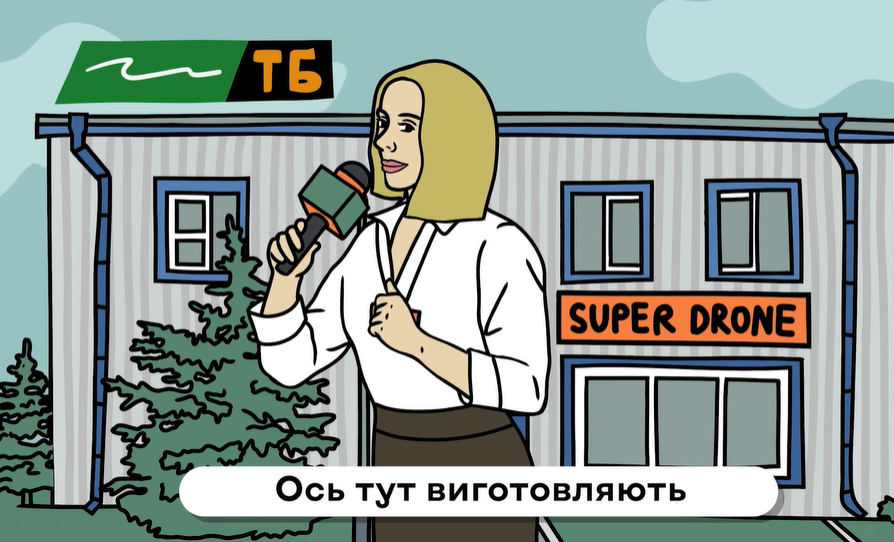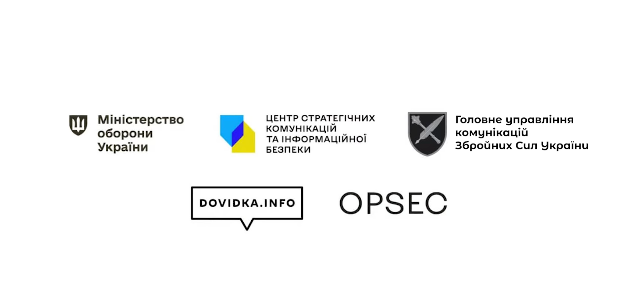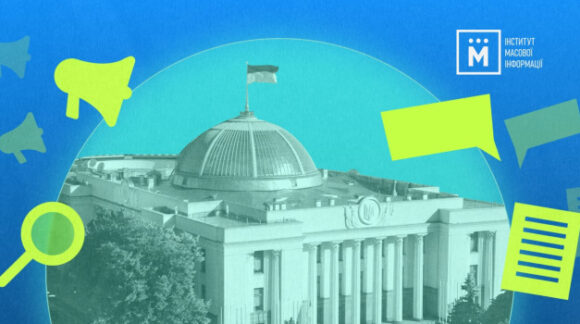Several state institutions have released an animated video produced by the Centre for Strategic Communications and Information Security, which implies that journalists are to blame for Russian shelling strikes.
The video was shared by the UAF General Staff, the UAF Communications HQ, and the Centre for Strategic Communications and Information Security on their social media.
The video features the motto “One news story – one strike.” In shows a reporter in front of a drone manufacturing facility, openly talking about it on camera and saying, “Hundreds of drones are produced here monthly.” An employee of the factory also says on camera that the company has doubled its capacity and that the new batch will soon be shipped off to the frontline. The video cuts to Russian intelligence officers who watched the news story and sent the coordinates of the facility to their general staff in preparation for the next strike.


Screenshots from the video by the IMI
Then, a missile hits the building and a fire truck drives by. Another reporter in the frame, standing next to the destroyed building, says that there was a “ballistic strike, hospitals are overloaded.” The journalist is shown without a bulletproof vest or a helmet and is reporting supposedly live from the site.
The state bodies that released the video added an identical caption to the clip, which reads, “Danger in the media: how information disclosure becomes a weapon in the enemy’s hands. In wartime, nothing is insignificant — everything matters. One news story made without approval can become a source of coordinates for the enemy. An unrestrained comment can become intelligence material. Unnecessary news release can cause a strike and casualties. Everyone who works with sensitive information must act responsibly and in compliance with the rules of information security.” The caption adds that “this video is a reminder for every reporter, service member, public figure, or official: silence is a weapon, too.”
“The Institute of Mass Information is seriously concerned with the release of the video clip that shifts the blame for the Russian shelling onto Ukrainian journalists. Such a narrative is very dangerous and false, because it undermines trust in the media, can put the lives of media workers at risk, and in general goes against the democratic principles that Ukraine is obliged to uphold even in wartime. Such an approach, with the motto ‘one news story — one strike,’ in no way contributes to improving information security. Unfortunately, it stigmatizes the entire journalist community and creates a pretext for pressure on all media workers who have been doing their job in good faith for years,” said Oksana Romaniuk, director of the Institute of Mass Information.
The video frames journalists as the ones at fault for Russian shelling, believes IMI media expert Olena Holub.
“The video by the Strategic Communications Centre frames journalists as the culprits of the shelling strikes, which is objectively a strange accusation to make. After all, journalists treat their work much more seriously and always consider the risks of their reporting, unlike social media users and various irresponsible bloggers. I agree that information should be treated as responsibly as possible and this should be discussed not with journalists specifically, but with society as a whole,” Olena Holub said.
The expert added that shifting the blame to journalists undermines trust in the media and encourages society to prioritize other sources of information that are less objective, accurate, and reliable.
Update. Ihor Solovey, the head of the Centre for Strategic Communications and Information Security, said in a comment to IMI representative Valentyna Troyan that the Center had produced this video jointly with the Ukrainian Armed Forces.
“This video was not produced in one day — all parties involved worked together for a long time before releasing it. And this video is a continuation of a series produced as part of the ‘Information Security’ project. There were 4 of such videos already, this is the fifth one. Thank you for paying attention to them. The idea for this particular video was conceived after a tragic incident when a news report like this led to a missile strike targeting a Ukrainian Armed Forces location, killing and wounding our soldiers,” Ihor Solovey explained.
When asked whether the authors of the video or people who commissioned it think that the video misrepresents the work of the media in covering the activities of the defense sector and reporting from shelling sites, Ihor Solovey emphasized that they do not.
He says the video is exclusively educational and aims to draw the attention of all citizens, including service members, to the issue of information security in wartime.
“Of course, it is a pity that certain phrases used in the material were misinterpreted by the media community. But believe me, there was no intention to single out anyone in particular. On the contrary, it is a reminder for everyone: not only for media professionals, but also for service members, public figures, and officials. A reminder that information released incorrectly can have a price, which is measured not just in money, but also in human lives. Have there been too few examples to understand such a simple rule?” remarked the head of the Centre for Strategic Communications and Information Security.
Previously
On March 28, 2022, Ukrainian and foreign journalists, as well as media and civil society organizations and movements, called on the authorities to immediately take all possible action to stop the harassment of journalists and develop transparent rules for covering Russian shelling.
Later, the Ministry of Culture and Information Policy of Ukraine, the Ministry of Defense, and the Media Movement came to an agreement and issued a statement proclaiming that journalists can collect information at shelling sites immediately after the strike. However, they must wait 12 hours after the end of hostilities before releasing photos and videos of military facilities and 3 hours for civilian facilities.
Moreover, the IMI has developed guidelines on talking with journalists for law enforcers and the military.
Valentyna Troyan, Kateryna Dyachuk

